Honeywell International Bundle
How Does Honeywell Stay Ahead in a Constantly Changing Market?
Honeywell International, a titan in technology and manufacturing, continually reshapes its portfolio to maintain its competitive edge. From its early days in heating controls to its current dominance across diverse sectors, Honeywell's evolution is a testament to its strategic foresight. Understanding the Honeywell International SWOT Analysis is crucial to grasping its position in the market.
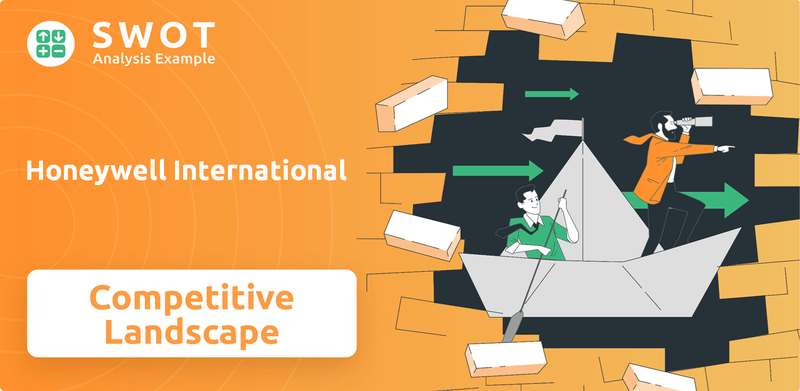
This exploration dives deep into the Honeywell competitive landscape, examining its key rivals and how it differentiates itself. We'll analyze Honeywell's market analysis, including its strengths, weaknesses, opportunities, and threats, to understand its strategic positioning. Furthermore, we'll assess Honeywell's industry dynamics and how its business strategy impacts its financial performance in a competitive environment.
Where Does Honeywell International’ Stand in the Current Market?
Honeywell International Inc. maintains a strong market position, leveraging its diversified portfolio across several key sectors. The company's strategic focus and operational excellence have enabled it to achieve significant revenue and maintain a competitive edge. Understanding the Honeywell competitive landscape is crucial for investors and industry analysts alike.
In fiscal year 2024, Honeywell reported sales of $36.9 billion, demonstrating its substantial scale within the industrial technology sector. This financial performance underscores the company's ability to generate significant revenue and sustain its market presence. The company's operations are structured around four primary segments, each contributing to its overall market position and growth.
Honeywell's business strategy is built on innovation and strategic market positioning. The company's diverse portfolio allows it to serve a wide range of customers and adapt to changing market dynamics. For a deeper dive into the company's growth strategies, consider exploring the Growth Strategy of Honeywell International.
Honeywell is a leading supplier in the aerospace sector, providing aircraft engines, avionics, and other systems. It serves both commercial and defense markets globally. This segment benefits from the continuous demand for aircraft components and technological advancements.
HBT holds a strong position in building management systems, fire and security solutions, and smart home technologies. The segment reflects a shift towards integrated digital offerings, catering to the growing demand for smart and connected building solutions. This segment is crucial for the Honeywell industry.
PMT is a significant player in process technologies, automation solutions, and advanced materials, serving industries like refining, petrochemicals, and pharmaceuticals. This segment drives innovation in process optimization and material science.
SPS provides personal protective equipment, gas detection technology, and supply chain automation solutions. This segment is committed to safety and efficiency, serving a wide range of industrial and commercial customers. This is a key area for Honeywell market analysis.
Honeywell's geographic presence is extensive, with a significant footprint in North America, Europe, and Asia. This global reach allows the company to serve a diverse customer base, including large corporations, governments, and individual consumers. Understanding Honeywell competitors and their global strategies is essential.
- North America remains a significant market, contributing a substantial portion of the company's revenue.
- Europe provides a strong market for building technologies and aerospace products.
- Asia continues to be a growth driver, particularly in building automation and safety solutions.
- The company's diverse customer base and global presence contribute to its resilience and market leadership.
Honeywell International SWOT Analysis
- Complete SWOT Breakdown
- Fully Customizable
- Editable in Excel & Word
- Professional Formatting
- Investor-Ready Format
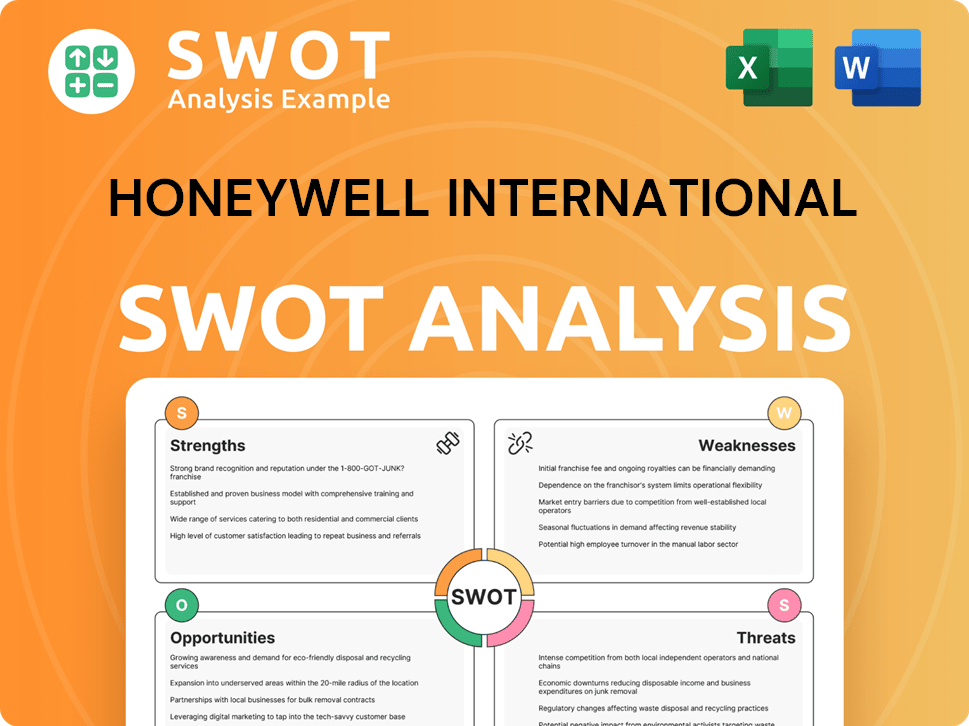
Who Are the Main Competitors Challenging Honeywell International?
Understanding the competitive landscape of Honeywell International is crucial for assessing its market position and future prospects. The company operates in diverse sectors, each with its own set of challenges and rivals. This analysis provides a detailed look at Honeywell's key competitors across its main business segments, offering insights into the dynamics shaping its financial performance and market share. Analyzing the Honeywell competitive landscape involves understanding the strengths and weaknesses of its major rivals and how they impact its strategic decisions.
Honeywell's financial performance is directly influenced by its ability to compete effectively against these companies. The competitive dynamics within each segment necessitate continuous innovation, strategic partnerships, and a keen understanding of market trends. For example, in the aerospace sector, Honeywell's success depends on its ability to outmaneuver competitors like RTX Corporation and GE Aerospace in providing advanced technologies and services.
The competitive landscape is constantly evolving, driven by technological advancements, market shifts, and economic factors. Honeywell's business strategy must adapt to these changes to maintain its competitive edge. This involves strategic investments in research and development, acquisitions, and collaborations to stay ahead of the competition and capitalize on emerging opportunities. The analysis of Honeywell's competitors is essential for investors, analysts, and business strategists seeking to understand the company's position in the market.
In the Aerospace sector, Honeywell faces significant competition. Key rivals include Raytheon Technologies (RTX Corporation), General Electric (GE Aerospace), and Safran S.A.
Honeywell Building Technologies (HBT) competes with established players and specialized firms. Siemens AG and Johnson Controls International plc are major competitors in this segment.
In Performance Materials and Technologies (PMT), Honeywell faces competition from companies like DuPont, BASF SE, and Emerson Electric Co.
In Safety and Productivity Solutions (SPS), Honeywell competes with 3M Company, Zebra Technologies, and various robotics and automation companies.
The competitive landscape is shaped by emerging players and technological disruptors. Industrial IoT, AI, and sustainable technologies are key areas of innovation.
Honeywell must continually innovate and adapt to maintain its competitive edge. Strategic investments, acquisitions, and collaborations are essential.
The Honeywell competitors landscape is complex, with each segment facing unique challenges and opportunities. The company's ability to navigate this competitive environment directly impacts its financial performance and market share. For instance, in the aerospace sector, the competition is fierce, with RTX Corporation and GE Aerospace being key rivals. In 2024, GE Aerospace reported revenues of approximately $32.7 billion, highlighting the scale of competition Honeywell faces. The building technologies segment sees Siemens AG and Johnson Controls as major competitors, each offering comprehensive solutions. The performance materials and technologies segment competes with DuPont and BASF, while the safety and productivity solutions segment faces competition from 3M and Zebra Technologies. The competitive analysis must consider the strategies and financial performance of these rivals.
- Aerospace: RTX Corporation, GE Aerospace, Safran S.A.
- Building Technologies: Siemens AG, Johnson Controls International plc.
- Performance Materials and Technologies: DuPont, BASF SE, Emerson Electric Co.
- Safety and Productivity Solutions: 3M Company, Zebra Technologies.
- Market Trends: Industrial IoT, AI, Sustainable Technologies.
Honeywell International PESTLE Analysis
- Covers All 6 PESTLE Categories
- No Research Needed – Save Hours of Work
- Built by Experts, Trusted by Consultants
- Instant Download, Ready to Use
- 100% Editable, Fully Customizable
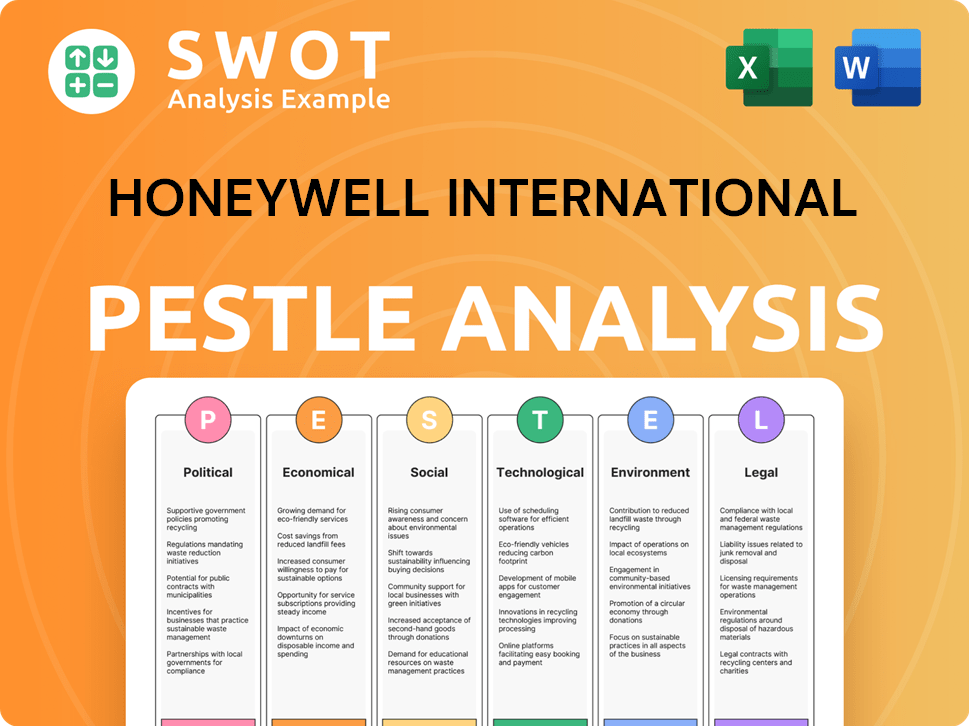
What Gives Honeywell International a Competitive Edge Over Its Rivals?
Understanding the competitive landscape of Honeywell International requires a deep dive into its core strengths. The company's ability to maintain a leading position in diverse sectors stems from a combination of technological prowess, strong brand recognition, and strategic market positioning. This analysis provides a comprehensive view of Honeywell's competitive advantages.
Honeywell's success is built on a foundation of innovation and strategic foresight. The company's commitment to research and development, along with its global presence, allows it to capitalize on emerging market trends. Honeywell's competitive advantages are further solidified by its financial performance, which reflects its ability to generate consistent revenue and maintain a strong market position.
Honeywell International's competitive edge is a result of its strategic focus and operational excellence. This analysis explores the key elements that contribute to its success in a dynamic market environment. For a deeper understanding of the company's strategic direction, consider exploring the Growth Strategy of Honeywell International.
Honeywell's competitive advantage is significantly bolstered by its extensive portfolio of proprietary technologies and intellectual property. This includes thousands of patents, particularly in the aerospace systems, industrial automation, and advanced materials sectors. These innovations enable the development of cutting-edge products and solutions, addressing complex customer needs effectively.
Honeywell's strong brand equity, cultivated over more than a century, is a key competitive advantage. This long-standing presence has fostered strong customer relationships, leading to significant customer loyalty and recurring revenue streams. This is especially true in markets with critical infrastructure and long-lifecycle products.
The company's global distribution network and comprehensive service capabilities offer a significant competitive edge. This allows Honeywell to reach customers worldwide and provide extensive post-sales support. These capabilities are essential for maintaining customer satisfaction and driving repeat business.
Honeywell's consistent investment in research and development ensures a continuous pipeline of innovative offerings. This commitment is crucial for maintaining a competitive edge in rapidly evolving markets. In 2023, Honeywell invested approximately $1.8 billion in R&D, underscoring its dedication to innovation.
Honeywell's strategic focus on digitalization and sustainability is embedded across its business units, enabling it to capitalize on emerging market trends. This approach allows the company to develop solutions for a more connected and environmentally conscious world. This focus is crucial for long-term competitiveness.
- Digital transformation initiatives enhance operational efficiency and customer experience.
- Sustainability efforts include developing sustainable aviation fuel technologies.
- These initiatives position Honeywell to meet evolving market demands and regulatory requirements.
- Investments in these areas are expected to drive future growth and market share gains.
Honeywell International Business Model Canvas
- Complete 9-Block Business Model Canvas
- Effortlessly Communicate Your Business Strategy
- Investor-Ready BMC Format
- 100% Editable and Customizable
- Clear and Structured Layout
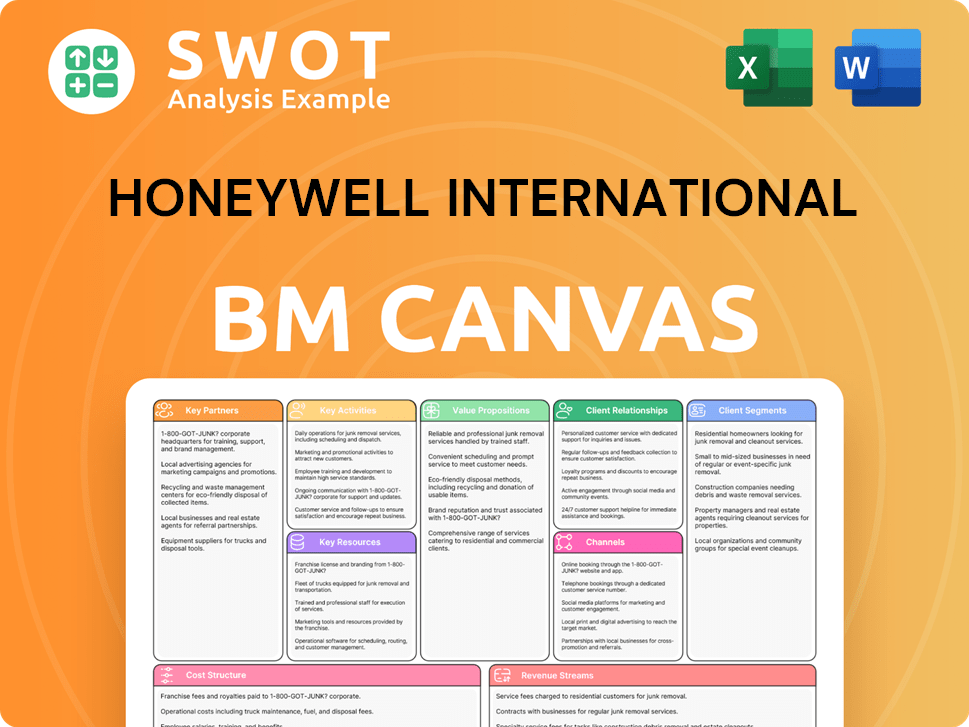
What Industry Trends Are Reshaping Honeywell International’s Competitive Landscape?
The Honeywell competitive landscape is significantly influenced by industry trends, offering both opportunities and challenges. Digital transformation and the Industrial Internet of Things (IIoT) are key drivers, increasing demand for connected solutions and automation. Sustainability initiatives and decarbonization efforts are also crucial, pushing industries toward energy-efficient solutions. For a deeper understanding of the company's origins, consider reading the Brief History of Honeywell International.
These trends necessitate continuous investment in research and development and pose challenges from new market entrants. Geopolitical uncertainties and supply chain disruptions further complicate global operations. However, Honeywell's business strategy is designed to capitalize on emerging markets and high-growth industries, enhancing its competitive edge.
Digital transformation and the IIoT are driving demand for connected solutions, predictive analytics, and automation. Sustainability and decarbonization initiatives are pushing industries towards more energy-efficient solutions. These trends present significant opportunities for Honeywell to grow and innovate.
Continuous investment in R&D is crucial to stay ahead of technological advancements. Increasing competition from new market entrants and geopolitical uncertainties pose challenges. Supply chain disruptions also impact global manufacturing and distribution.
Emerging markets, especially in Asia and the Middle East, offer significant growth potential. Strategic focus on high-growth industries like quantum computing and sustainable technologies enhances future outlook. Honeywell is well-positioned to capitalize on evolving trends.
Strategic acquisitions, partnerships, and continued innovation are key to maintaining a competitive edge. Honeywell's ability to adapt to evolving trends will be crucial for future growth. Focus on high-growth industries and emerging markets is essential.
Honeywell's market analysis reveals that the company is strategically positioned in several key sectors. Its ability to innovate and adapt to market changes is crucial for long-term success. The company's focus on sustainability and digital transformation is a key aspect of its competitive strategy.
- Digital Transformation: Honeywell is investing heavily in digital solutions, with its Forge software playing a key role. In 2024, the company increased its digital solutions revenue by approximately 15%.
- Sustainability Initiatives: Honeywell is focused on sustainable aviation fuel and building technologies. The company aims to reduce its carbon footprint and help customers do the same.
- Emerging Markets: Expansion in Asia and the Middle East is a priority. Honeywell's sales in these regions grew by 8% in 2024, demonstrating the importance of this strategy.
- Research and Development: Honeywell continues to invest in R&D to stay ahead of technological advancements. R&D spending in 2024 was approximately $2 billion.
Honeywell International Porter's Five Forces Analysis
- Covers All 5 Competitive Forces in Detail
- Structured for Consultants, Students, and Founders
- 100% Editable in Microsoft Word & Excel
- Instant Digital Download – Use Immediately
- Compatible with Mac & PC – Fully Unlocked
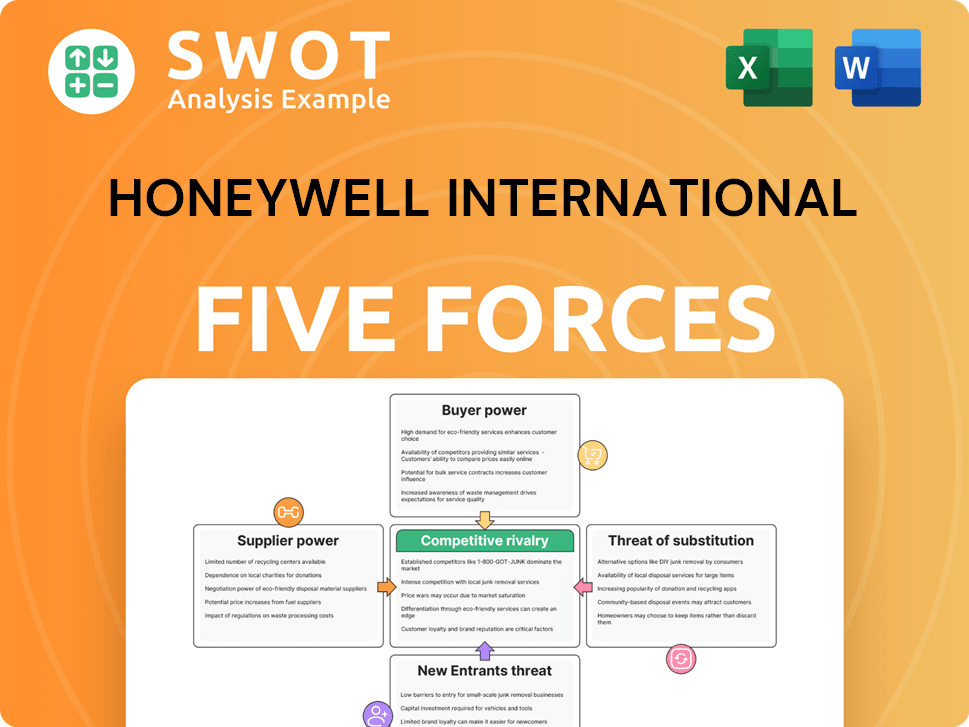
Related Blogs
- What are Mission Vision & Core Values of Honeywell International Company?
- What is Growth Strategy and Future Prospects of Honeywell International Company?
- How Does Honeywell International Company Work?
- What is Sales and Marketing Strategy of Honeywell International Company?
- What is Brief History of Honeywell International Company?
- Who Owns Honeywell International Company?
- What is Customer Demographics and Target Market of Honeywell International Company?
Disclaimer
All information, articles, and product details provided on this website are for general informational and educational purposes only. We do not claim any ownership over, nor do we intend to infringe upon, any trademarks, copyrights, logos, brand names, or other intellectual property mentioned or depicted on this site. Such intellectual property remains the property of its respective owners, and any references here are made solely for identification or informational purposes, without implying any affiliation, endorsement, or partnership.
We make no representations or warranties, express or implied, regarding the accuracy, completeness, or suitability of any content or products presented. Nothing on this website should be construed as legal, tax, investment, financial, medical, or other professional advice. In addition, no part of this site—including articles or product references—constitutes a solicitation, recommendation, endorsement, advertisement, or offer to buy or sell any securities, franchises, or other financial instruments, particularly in jurisdictions where such activity would be unlawful.
All content is of a general nature and may not address the specific circumstances of any individual or entity. It is not a substitute for professional advice or services. Any actions you take based on the information provided here are strictly at your own risk. You accept full responsibility for any decisions or outcomes arising from your use of this website and agree to release us from any liability in connection with your use of, or reliance upon, the content or products found herein.